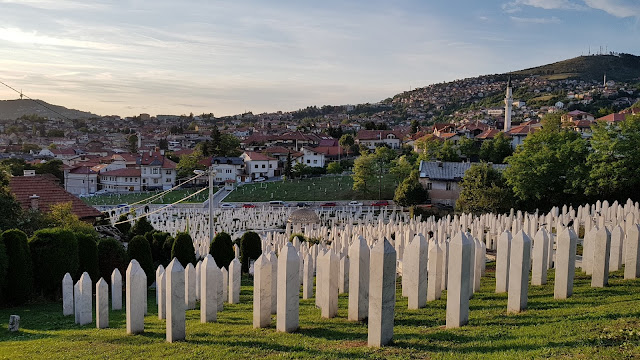In the morning I continued my journey to Sarajevo. It would be a long driving journey so I decided to visit Boracko Jezero (Lake) along the way. It was a scenic drive where I had made a few stops for photography. At some places, I saw some farms but they did not seem to be well maintained as those in New Zealand.
Boracko jezero is a glacial lake with an elliptical shape. It was very quiet as there were not many houses and traffic. When I finally reached Baracko Jezero, I had difficulty to find the entrance or a good spot to stop. I found a campsite and parked my car there but eventually I was shamed to walk to the lake from there since I was not their guest. I ended up stopping at somewhere near Manuel Cafe or Caffe "M" Lavazza which may not be the best spot but there were a few benches so I could sit down and enjoy the view.
The reflection of the surrounding forest was clearly visible in the crystal clear waters of the lake. I could even see tadpoles swimming in the lake.
When I searched some online pictures of Boracko Jezero while writing this post, I did realize I might not have stopped at the best spot. Some say the best place is next to the restaurant, next to the stream and with plenty of luxurious shade but they do not mention the restaurant name. There is a cafe nearby which sells nothing else but coffee.
I went to the Tunnel Museum. I am not a museum lover but this was the place I was really curious to see the most in Sarajevo. This museum displays artefacts related to the tunnel built during the siege of Sarajeve during the Bosnian War in 1990s. It shows visitors the past of Sarajevo. Bullet holes and mortar scars can be seen on the building.
I arrived in the Sarajevo city center in the evening and we checked in to our apartment "Guest House Bosnian House". We were welcomed by the host and her son with traditional Bosnian coffee. They were the best host ever who offered great hospitability. The son shared visiting and dining tips in Sarajevo. At times, we shared our past travel experience with each other. The host recommended burek from Oklagija cafe in the old town which was really good and most importantly it was cheap. The burek was freshly made and it was still warm.
It was just the correct time to walk up to the Yellow Fortress to view the beauty of Sarajevo from above and enjoy the sunset. It was only about 15-minute walk up hill from old town. The Martyrs' Cemetery was along the way. It hosts many Islamic Muslim tombstones in white color. It is the main cemetery for soldiers from the Bosnian Army who were killed during the aggression against Bosnia and Herzegovina (April 1992 - December 1995).
I was crazily craving for Turkish food since the last meal I had in Mostar. I knew this would be my last opportunity to have one again before I left Sarajevo tomorrow. I chose to have my dinner at Kod Keme which appeared to be a family restaurant with its cozy decoration. I ordered a bowl of chicken soup and Gulas, which is highly seasoned stew of meat served with pita bread. The food was fine but not fantastic.
Despite having visited to many old towns in past few days, Sarajevo Old Town is different with a mix of Ottoman, Austro-Hungarian, Slavic, Muslim, Orthodox, Catholic and Jewish cultures. Bascarsija is Sarajevo's old bazaar and the historical and cultural center of the city.
I noticed 80% of the body was covered by advertisement in all buses
Home made pizza opposite the cemetery. No fancy flavors but you can choose the meat (chicken/beef)
There were two mosques which impressed me most. One of them was Careva (Emperor's) Mosque which is the oldest mosque in Sarajevo and one of the oldest of its kind in BiH.
The other one is the Gazi Husrev-bey Mosque, which is the largest historical mosque in Bosnia and Herzegovina and one of the most representative Ottoman structures in the Balkans.
Plums, called šljiva in local languages could be seen absolutely everywhere – piled high in open-air markets, on fruit stands along country roads, even dotting the ground in Sarajevo’s city parks.
















































No comments:
Post a Comment